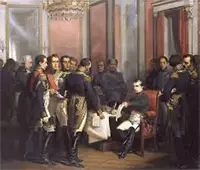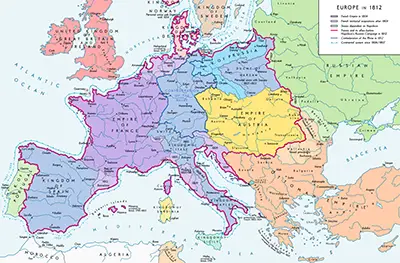Napoleon Bonaparte: Giant of the Age
Part 11: The Allies Triumph
While the remnants of the Grand Armée staggered back out of Russia, the French emperor Napoleon Bonaparte had traveled more quickly back to Paris, amid reports of an attempted coup. He had enough support left in the capital to nullify any challenge to his authority or his crown. In the meantime, however, the other powers of Europe had united against him more than ever before. France still had a large population (including allies) at this time, and Bonaparte was able to put together another large army, this one numbering 400,000. In May 1813, French troops won two significant battles, at Lützen and Bautzen, involving large total numbers of troops than had yet been seen. The significance for France was that the victories resulted in a cease-fire. However, French losses for both battles combined were about as much as for the Allies. During this time as well, French troops were losing battles and territory in Spain. The Peninsular War, which Bonaparte had sparked by instigating a coup in Spain, had dragged on for five years and had consumed large amounts of manpower and munitions that could have been employed elsewhere. The transfer of tens of thousands of troops from the Spanish war to the invasion of Russia didn't help either effort, in the end. The cease-fire lasted from June to August. During that time, the Allies succeeded in enlisting Austria to join the Sixth Coalition. By this point, the main French and allied force numbered 650,000, about the same size as the army that had invaded Russia; on the other side resided nearly 800,000 Allied troops in the main force. When the fighting resumed, with Austria installed against France, the French won again, at Dresden. However, the Allied forces scored victories of their own–at Großbeeren, Katzbach, Dennewitz, and (most significantly) Kulm. Many at this time and since have referred to the War of the Sixth Coalition Leaders of the major powers met in Frankfurt; the terms that they offered to Napoleon became known as the Frankfurt Proposals. Allied leaders demanded that France resume its "natural boundaries," meaning giving up all territory won in Germany, Italy, Poland, and Spain. Even though the proposal allowed France to keep control of Belgium, Savoy, and the Rhineland and allowed Bonaparte to keep his imperial title and throne, he refused the offer and the war continued. Just a few weeks later, on November 9, 1813, a joint Portuguese-U.K. force, having scored a knockout blow against French troops in Spain at the Battle of Vitoria in June, crossed over the Pyrenees and invaded France. Allied troops were soon invading France from the north. 
Once Allied forces were within France's traditional borders, the end came rather quickly. Even the vaunted Napoleon could not compete with overwhelming numbers of men and weapons arrayed against him and his beleaguered, dispirited men. After a brief series of French victories in the Six Days' campaign, Allied troops entered Paris on March 30, 1814. The Allied force that had invaded from the south seized Toulouse after a four-day battle. On April 11, Bonaparte abdicated the throne but only after his marshals mutinied and demanded that he do so, refusing to follow any more of his orders. On that day, France signed a treaty with all countries but the U.K. That pact, the Treaty of Fontainebleau, ended the war except for the fighting that was still going on in southern France. The Treaty of Paris, signed on May 30, 1814, by France and the U.K., officially ended the War of the Sixth Coalition. Following on from that was the Congress of Vienna, which redrew the map of Europe. Napoleon was exiled to the island of Elba. The new leader of France was King Louis XVIII, who had ordered the last surrender, that of Davout in Hamburg, on May 27. Napoleon, meanwhile, traveled aboard the Undaunted to Elba, an island in the Mediterranean 12 miles off the coast of Tuscany. He took a suicide pill, but it was so old that it didn't work. Allowed to keep the title of emperor, he set about reorganizing the island and its government, administration, and laws. Meanwhile, his wife and son were living in Austria. Next page > Abdications and the Hundred Days > Page 1, 2, 3, 4, 5, 6, 7, 8, 9, 10, 11, 12 |
|
Social Studies for Kids
copyright 2002–2025
David White



 Officers in the Prussian and Russian forces in late December 1812 hammered out the Convention of Tauroggen, which severed the enmity that existed between the two powers because Prussia was technically allied with France. That initial understanding led to the Treaty of Kalisch, which added Sweden and the United Kingdom to the list of powers dedicated to opposing France. Thus, on Feb. 28, 1813, was born the Sixth Coalition. Sardinia and Sicily eventually joined as well. Sweden declared war on France on March 3; the Prussian declaration of war came two weeks later.
Officers in the Prussian and Russian forces in late December 1812 hammered out the Convention of Tauroggen, which severed the enmity that existed between the two powers because Prussia was technically allied with France. That initial understanding led to the Treaty of Kalisch, which added Sweden and the United Kingdom to the list of powers dedicated to opposing France. Thus, on Feb. 28, 1813, was born the Sixth Coalition. Sardinia and Sicily eventually joined as well. Sweden declared war on France on March 3; the Prussian declaration of war came two weeks later. as the War of German Liberation. A significant part of that liberation came at the
as the War of German Liberation. A significant part of that liberation came at the 
